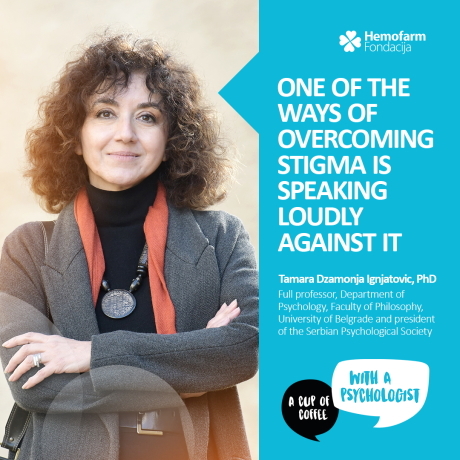
05/10/2022
STIGMATIZATION OF PEOPLE WITH MENTAL DISABILITIES - HOW TO OVERCOME IT
Prof. Tamara Džamonja Ignjatović
PhD, full professor, Department of Psychology, Faculty of Philosophy, University of Belgrade and president of the Serbian Psychological Society
STIGMATIZATION OF PEOPLE WITH MENTAL DISABILITIES - HOW TO OVERCOME IT
Increasing visibility of the topic of mental disorders is associated with an increased need for services aimed at improving mental health, as well as providing assistance to people with mental disorders. According to the research findings, nowadays around 15% of citizens meet the criteria for a mental disorder. 35% of them have mental health difficulties, of which almost a half have never sought help, and of those who acutely experience some difficulties, 70-80% have not sought help.
In addition to a number of objective obstacles to obtaining professional help, such as limited resources, physical and financial unavailability of services, lack of information, interdepartmental cooperation, but also legal regulations regarding standards and quality control of rendering these services, etc., one of the significant sources of obstacles is stigmatization of persons with mental problems.
Stigma occurs when a certain characteristic of a person, which deviates from social norms, is generalized so that one of its aspects becomes a defining characteristic of that person as a whole, which is therefore assigned a negative evaluation. People with mental problems are among the most stigmatized groups in the world, which is why they often suffer discrimination and marginalization.
Distrust and prejudice cause discriminatory attitude towards psychiatric patients
Although their position has improved, fear and mistrust towards psychiatric patients have not disappeared, and such prejudice leads to discriminatory, unequal treatment, which endangers the civil rights of these persons. They are perceived as unpredictable and even potentially dangerous, contrary to the research data which show that only 3-5 percent of total violence is committed by people with psychological difficulties, while they themselves are more often victims of verbal or physical violence.
Stigmatization of persons with mental disorders
Stigma can occur in different forms.
Public stigma refers to the negative reaction of the public towards people with mental disorders and is manifested through negative stereotypes, prejudice and discriminatory behaviour.
Self-stigma occurs when people with these problems adopt such attitudes themselves, that is, internalize the way the environment perceives and treats them, which damages their self-esteem and leads to self-blame, shame and social withdrawal. Stigma can be
experienced or anticipated, when a person expects and fears that he or she will be negatively evaluated and rejected by others, which is why they usually protect themselves by social withdrawal. The research recently conducted by the non-governmental organization PIN (Psychosocial Innovation Network) confirms that the social distance towards people with mental health problems remains huge. The perception of public stigma, which represents an individual's belief that other people will devalue or discriminate against people with mental disorders, shows that beliefs about public stigma are even more pronounced. In other words, people believe that the environment rejects these individuals more than they themselves do or are willing to admit. Nevertheless, people who have close contact with people with mental disorders have a lower level of social distance, but therefore perceive the presence of public stigma in society to a greater extent. Such attitudes are present even among healthcare workers, so we can talk about
iatrogenic stigmatization, which manifests itself through the careless use of diagnostic labels or unjustified prescription of medicinal products, ignoring of patients’ complaints about somatic difficulties because they are considered the effect of a psychological disorder, as well as avoiding discussing the diagnosis with patients and their families. We should also take into account the
structural stigma that arises from the direct or indirect influence of laws and regulations that reduce the rights and opportunities of people with mental disorders. It is especially important to highlight the
media stigma that is reflected through promoting of stigmatizing attitudes by focusing on the negative aspects of people with mental health issues, which has a strong influence on the maintenance of public stigma and the development of self-stigmatization accompanied by secondary distress.
Consequences of stigmatization
Stigma has far-reaching negative consequences for people with mental disorders, but also for their families. They often encounter rejection or avoidance of the environment, have fewer chances to acquire a higher education, fewer opportunities to get a job, but also to keep a job or get a promotion, it is more difficult for them to find a partner or maintain an emotional relationship, they get married less often, it is harder for them to rent an apartment, etc. The family suffers additional pressure due to increased care for their member, facing actual or anticipated stigmatization and social isolation, and may also develop feelings of shame, guilt, and responsibility for their member's psychological problems. It is precisely self-stigma that deters people and their families from seeking help, their problems are hidden, denied or minimized, thereby reducing the chances of successful recovery.
Overcoming stigmatization
Overcoming stigmatization is a prerequisite for timely therapy, treatment outcome and resocialization of a person. The first step in that process is to stop using stigmatizing names and offensive terms.
Destigmatization should be aimed at providing mental health support in the community, outside of psychiatric clinics, making these services accessible and non-stigmatizing. Education is the most common strategy, which includes campaigns aimed at the general public, but also work with target groups, such as healthcare professionals, and especially journalists, but also others. Finally, direct experience with people who are successfully treated for mental disorders and lead responsible and productive lives may be the most effective method in reducing negative attitudes.

AUTHOR
Prof. Tamara Džamonja Ignjatović
PhD, full professor, Department of Psychology, Faculty of Philosophy, University of Belgrade and president of the Serbian Psychological Society